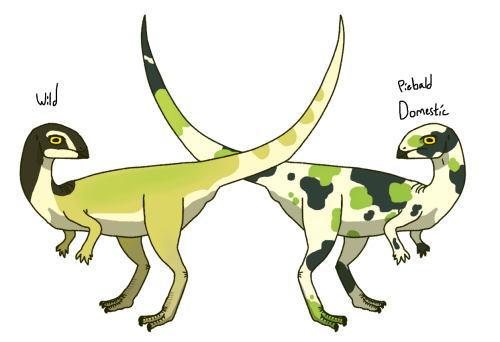The principal dinosaurs of the plains, whether hunted and domesticated by halflings since time immem
The principal dinosaurs of the plains, whether hunted and domesticated by halflings since time immemorial. All of these dinosaurs, of the medium to small, unadorned and ornithopod variety, are called fastieth.Dryosaurs are the most famous fastieth, known for their use as steeds by the tribal halflings. Unlike Camptosaurus, Dryosaurus utilizes speed as their primary defense against predators. This, coupled with their striped tails, makes a herd of dryosaurs running zig-zaggedly across each other’s paths hard on the eyes and obscures them from predators. Dryosaurs live in relatively large, 100-150 member, horse-like herds with a small group of breeding males and many females and youngsters. Lesser males usually trail behind. These fastieth live in the wide brushy basin year-round, but can also be found in the forests. Forest dryosaurs are smaller, less social, but also faster. Despite their speed, dryosaurs are not very agile and cannot jump high. In the wild they run parallel to one another in straight lines as defense against predators. These fastieth have been domesticated by halflings for millennia and are incredibly ingrained into their society. Wild ones are not hunted as often as camptosaurs and rarely bred due to their jumpy tendencies. Halfling religion, a mixture of animism and animal worship, contains many references to the dryosaurs and treats them like the “other half” of the hunter. They are treated with honor, and killing one, even for practical purposes, is very taboo. It’s even believed that the halfling hunting mask is specifically designed to look unthreatening and friendly to their saurian mounts. Other races find them too small to ride, but a small riders club in Zilargo, populated by gnomes, has gained in popularity ever since the Last War’s end. Dryosaurs produce their green coloration with two different coloration systems: both yellow and blue (cyan) pigment cells. How many blue pigments they produce depends on the amount of water they drink. This means during the dry season they produce very little blue, making them yellow, while in the wet season they produce a lot of blue, making them green, and allowing them to blend in with the lush ferns. Because of this, domesticated dryosaurs range from bright green to cyan. Recent breeding has even produced pastel blue mounts. Their dark masks are harder to select for when breeding as they are an ancient trait (the exception being the piebald morph popular in Zilargo). Selecting for and against stripes is easier, as there is a lot of variation in wild dryosaurs. Normally they have light stripes on only their tail, but forest dryosaurs have dark melanin stripes. Depicted above is a typical wild fastieth and the most common breed of domesticated fastieth used by the Talenta. As well as a piebald variant found only in cosmopolitan breeding circles in Zilargo. -- source link
#dinosaur#paleoart#dryosaurus#fastieth#eberron#talenta plains#talenta#ecology#world building

